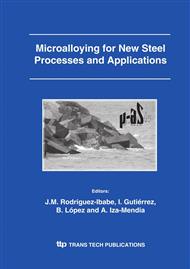p.565
p.573
p.581
p.589
p.597
p.605
p.613
p.623
p.631
Influence of Deformation and Coiling Temperature on Mechanical Properties of a High Strength Pipeline Steel
Abstract:
One of the components required to successfully produce high strength pipeline steel is to optimize precipitation strengthening. Some high strength pipeline grades rely on increased levels of Nb; in these grades, it is important to ensure that all the Nb is effectively employed. It is generally accepted that choice of coiling temperature is critical in maximizing the Nb precipitation in ferrite. Additional control of this precipitation may be attained by deformation at these coiling temperatures, an approach termed ‘cool deformation’. In this work, steel specimens were heated to temperature of 1200°C and held at temperature for 20 minutes to ensure significant dissolution of Nb precipitates. Some specimens were aged at 400°C for times ranging from 10 minutes to 10 hours followed by air-cooling. Others were subjected to deformation at 400°C (‘cool deformation’) prior to aging. It was found that the cool deformation improves the mechanical properties by microstructure; both yield and tensile strengths are significantly higher than that of the aged only specimens. By using low voltage imaging on a field emission gun scanning electron microscopy (FE-SEM), precipitates were observed and identified. The effects of the thermal and cool deformation schedules on the precipitate characteristics are described in this paper.
Info:
Periodical:
Pages:
597-604
Citation:
Online since:
November 2005
Authors:
Price:
Сopyright:
© 2005 Trans Tech Publications Ltd. All Rights Reserved
Share:
Citation:


